Outcome
1: Accessible, reliable and safe public transport system
top
of page
Effectiveness
indicators
The PTA’s outcome of an accessible, reliable
and safe public transport system is seen as a key requirement
for increasing the use of public transport. Achieving a sustainable
increase in the use of public transport depends on accessibility,
reliability and safety.
The
PTA was established on 1 July 2003. Comparative data for the
performance indicators has been derived from details previously
recorded by the Department for Planning and Infrastructure
or the Western Australian Government Railways Commission.
The
PTA’s effectiveness in meeting its outcome on the provision
of an accessible, reliable and safe public transport system
is measured by the following criteria:
1.
Use of public transport
2. Service reliability
3. Level of overall customer satisfaction
4. Customer perception of safety
5. Level of notifiable safety incidents
Use
of public transport
Metropolitan and regional passenger services
Passengers
per service kilometre
The use of public transport is measured by comparing the annual
number of passengers against the number of productive service
kilometres. A service kilometre is a kilometre where passengers
are carried. This effectiveness indicator is applied to each
mode of public transport.
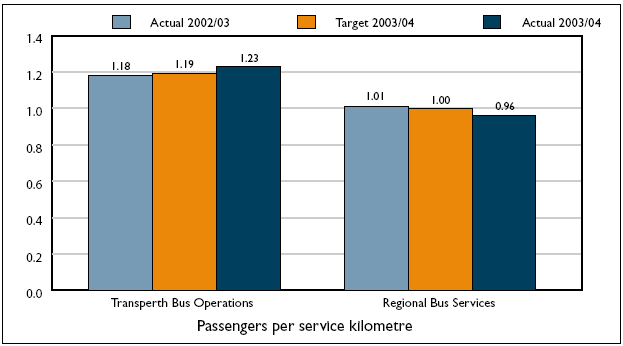
Transperth
Bus Operations: The 2003/04 data included the March
2004 count of boardings on CAT (Central Area Transit) and
FTZ (Free Transit Zone) services. The previous year actual
and the target were based on the results of the last count
done in 2000. The inclusion of this additional patronage from
March 2004, combined with an increase in fare-paying boardings,
contributed to the improvement in bus passengers per service
kilometre in 2003/04.
Regional
Bus Services: Passenger numbers on the Port Hedland,
Esperance, Karratha and Mindarie services fell in 2003/04
due to local regional factors. In addition, the actuals for
2003/04 include the Perth to Port Hedland trial road coach
service, which is a long haul and does not attract that many
passengers. The target did not include this journey, hence
the decline in the overall passengers per service kilometre.
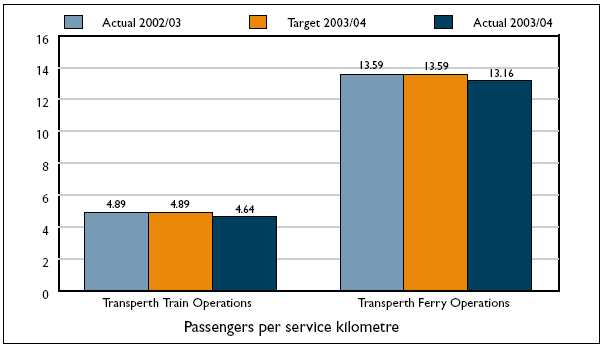
Transperth
Train Operations: The decline in train passengers
per service kilometre in 2003/04 was due mainly to a temporary
decline in boardings resulting from a period of industrial
action during the year.
Transperth
Ferry Operations: Ferry boardings continued to decline
while service kilometres operated remained unchanged. Approximately
half of the ferry patrons are tourists. The ferry service
is therefore very susceptible to tourism fluctuations such
as downturns associated with international economic issues
and tourism security concerns. These issues have impacted
ferry numbers for the last few years.
Country
passenger rail and road coach services
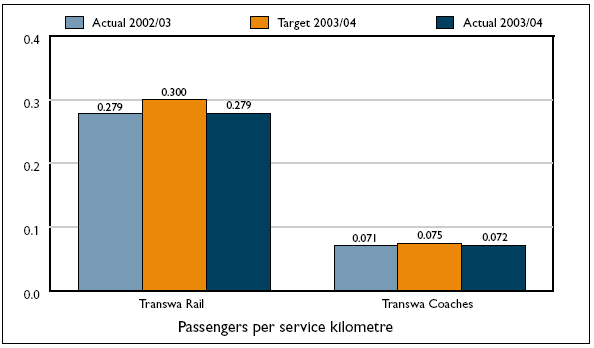
The rail
targets for 2003/04 were not met due to the late introduction
of the new Prospector service.
Coaches
were in line with targets.
Service
reliability
According to an independent survey to measure
customer satisfaction, service reliability is ranked as one
of the most significant characteristics of a quality service.
Service reliability is essentially a combination of two main
factors; punctuality and consistency.
Metropolitan
and regional passenger services
Punctuality is defined by acceptable parameters
that are considered to represent on-time arrival. These are
shown below for each operation:
| Operation |
On-time
arrival parameter |
Transperth
bus
|
4
minutes |
| Transperth
train |
3
minutes |
| Transperth
ferry |
3
minutes |
|
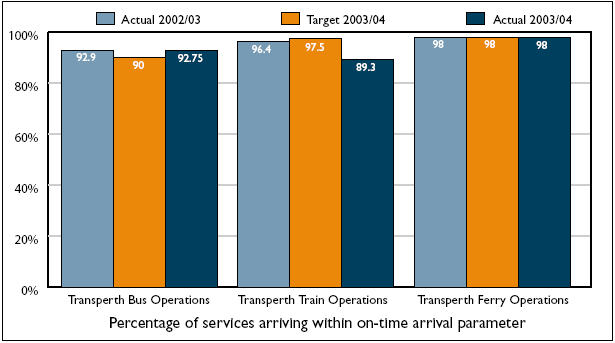
Bus service
reliability has almost been maintained at the 2002/03 level
despite disruptions caused by roadworks associated with the
New MetroRail project. For the train services, on-time running
delays were mainly due to a period of industrial action during
the negotiation of award conditions.
Country
passenger rail and road coach services
| Operation |
On-time
arrival parameter |
Prospector
|
15
minutes |
| Australind |
10
minutes |
| AvonLink |
10
minutes |
| Coaches |
10
minutes |
|
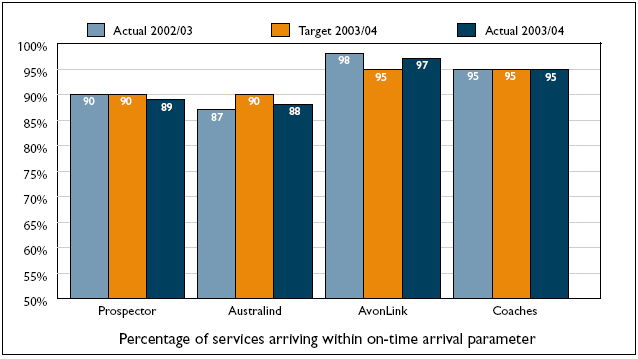
Results
are in line with targets.
Regional
school bus services
For
the regional school bus services, the on-time arrival parameter
is to arrive at school no less than 10 minutes before school
starts and within 10 minutes of school ending.
This was
not measured during the year as no system of measurement was
in place at the time.A system has now been developed and implemented
and this will be measured in 2004/05.
Level
of overall customer satisfaction
Metropolitan and regional passenger
services
The percentage of patrons that were satisfied with services
overall measures public perception of the organisation’s
performance in providing a high-quality and attractive passenger
service. The measure is derived from an extensive annual survey
conducted by independent consultants who interview a large
sample of passengers. Interviewers were assigned to various
services and transit station locations over a four-week period
covering the working week and weekend. A questionnaire was
used by the interviewer and respondents were asked to provide
a wide range of responses regarding their views on public
transport performance.
The passenger
satisfaction survey results provide an objective, unbiased
view over time of patrons’ overall satisfaction with
the system, e.g. safety, on-time running, courtesy of staff,
service frequency and train and station amenities. The information
is used by management to develop strategies for improving
service performance and infrastructure.
The sample
error estimate is within + or – 2% to 3% at 95% confidence
level for Transperth Bus and Ferry Operation; + or –
6% at 95% confidence level for Transperth Train Operations.
The data
is collected from the Passenger Satisfaction Monitor 2004,
the annual survey carried out by consultants for Transperth.
The 2004 results show that the high levels achieved in 2003
have been maintained.
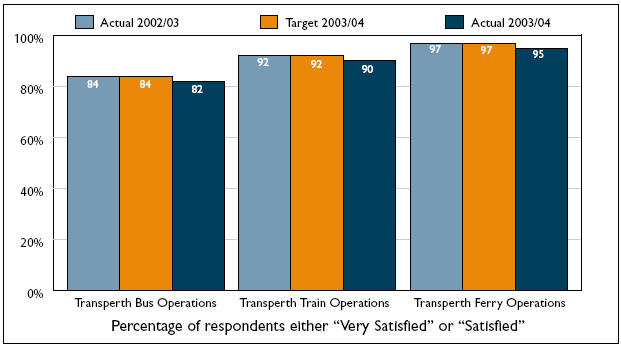
Country
passenger rail and road coach services
In 2004 an independent passenger satisfaction survey was undertaken
for each service – Australind, Prospector and coaches.
Overall satisfaction remains very high at 88%,with 40% of
passengers indicating they were very satisfied and a further
48% satisfied, indicating a high level of passenger satisfaction.
The sample
error estimate is within + or – 3% to 5% at 95% confidence
level.
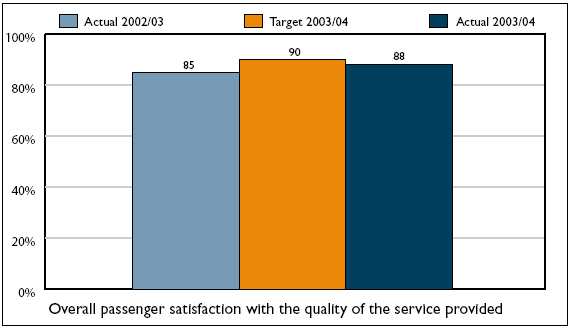
Customer
perception of safety
How safe customers feel on trains and buses and at stations
is an important factor in deciding to use public transport.
The PTA has invested capital funds in security-related infrastructure
and increased its security staff to ensure that customers
can see tangible measures to increase their safety. Perception
is measured by survey and distinguishes between trains and
buses and at stations, at night and during the day.
Metropolitan
and regional passenger services
Transperth Trains
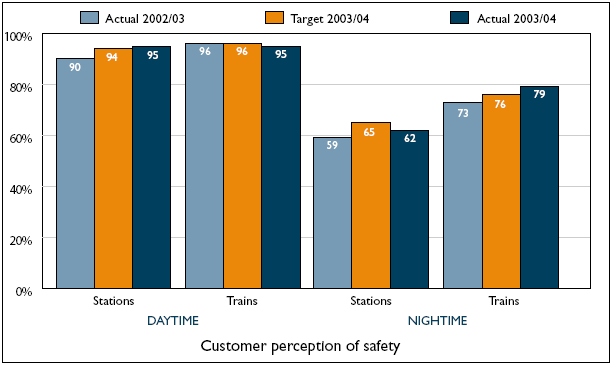
Transperth
Buses
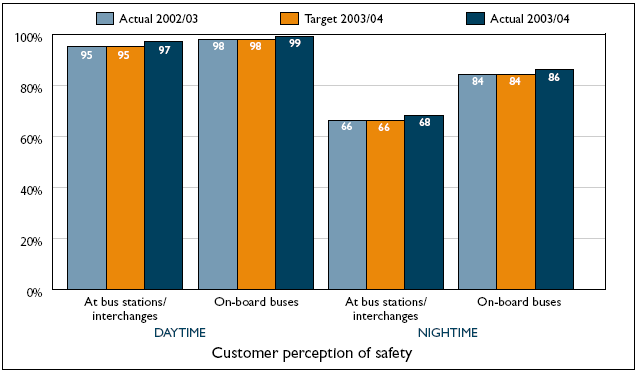
The data
is derived from the Passenger Satisfaction Monitor 2004, an
annual survey carried out by consultants for Transperth. The
2004 results show that the high levels achieved in 2003 have
improved, particularly at night time.
Level
of notifiable safety incidents
Metropolitan and regional passenger
train services
Safety incidents are recorded and notified to the Office of
Rail Safety. These incidents are termed notifiable occurrences
and are defined in the Rail Safety Regulations 1999 as Category
A (serious injury, death, or significant damage) or Category
B (potential to cause a serious accident).
The performance
measure for Category A and B occurrences is expressed as the
number of occurrences per million passenger boardings and
per million train kilometres. A low level of incidents indicates
that sound safety procedures and controls exist and are operating
effectively throughout the rail system.
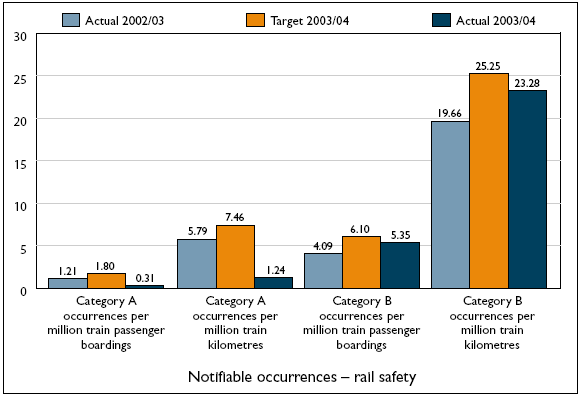
Safety
incidents were below target, indicating that procedures and
controls, particularly in the area of identifying and controlling
risk, are operating effectively.
Regional
school bus services
Accidents attributable to all causes are notified to and recorded
by the Team Leader Vehicle Inspector.
The performance
measure for the notifiable occurrences is expressed as the
number of notifiable occurrences (accidents) reported during
the school year. A low level of incidents indicates that sound
safety procedures and controls exist and are being adhered
to throughout the regional school bus fleet.
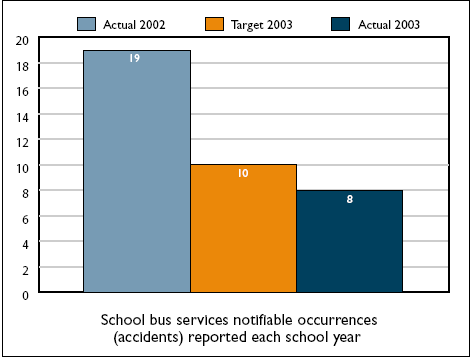
The reduced
number of accidents involving school buses shows a concerted
effort by the PTA and school bus industry to maintain high
safety standards. Driver awareness of road conditions has
also assisted in this area.
Efficiency
indicators
Output 1 – Metropolitan and regional passenger services
Cost per passenger kilometre
The cost per passenger kilometre measures the cost-efficiency
of providing passenger services, expressed as the cost of
carrying one passenger one kilometre.
It is
calculated by dividing the total annual cost for each service
mode by the number of passengers and the average distance
travelled.
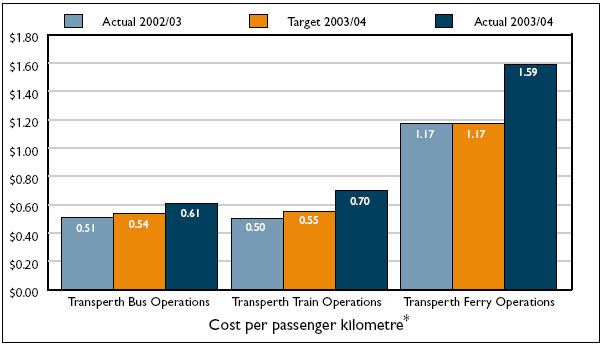
*Passenger
kilometres are a management estimate derived from the zonal
distribution of ticket sales because actual average passenger
trip length is not known
Transperth
Bus and Ferry Operations: The increase in the average
cost compared to the target and the previous year’s result
was mainly due to an increase in depreciation charges following
the revaluation of assets and a reallocation of the capital
user charge levy.
Transperth
Train Operations: The increase in the average cost
compared to the target and the previous year’s result
was mainly due to an increase in depreciation charges following
the revaluation of assets and a reallocation of the capital
user charge levy which was not previously applied to the former
Western Australian Government Railways’ assets.
Output
2 – Country passenger rail and road coach services
Cost per passenger kilometre
The cost per passenger kilometre measures the cost-efficiency
of providing passenger services, expressed as the cost of
carrying one passenger one kilometre.
It is
calculated by dividing the total annual cost for each service
mode by the number of passengers and the average distance
travelled.
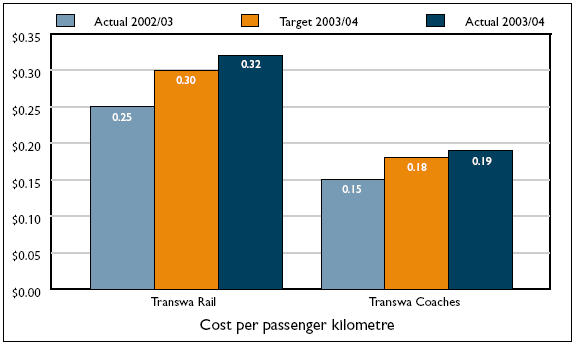
The results
for 2003/04 were close to target. The increase compared to
last year is largely attributable to the capital user charge
levy which was not previously applied to the former Western
Australian Government Railways’ assets.
Output
3 – Regional school bus services
Cost per 1,000 student place kilometres
The cost-efficiency measure for school bus services measures
the availability of place kilometres provided to meet student
requirements.
It is
calculated by dividing the total average cost of the service
by the number of student places on each service and the distance
travelled.
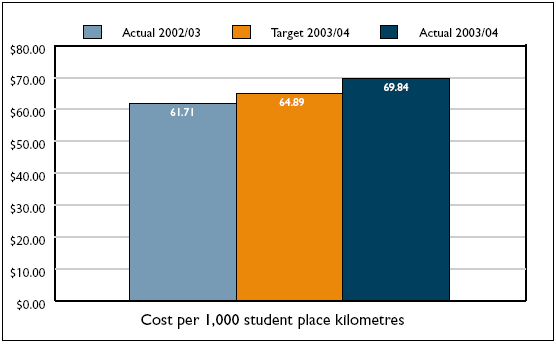
The increase
compared to both target and last year is mainly due to the
renegotiation of the majority of school bus contracts, which
resulted in increased rates, and there was a substantial back
pay adjustment in 2003/04.
Outcome
2: Protection of the long-term functionality of the leased
rail corridor and railway infrastructure
top
of page
Effectiveness
indicator
The most significant issue for this outcome is the management
of the long-term lease of the rail freight infrastructure
to Westnet Rail Pty Ltd. An independent inspection of the
railway infrastructure is carried out every five years. The
first inspection will be carried out in 2005/06. The results
of this inspection will be reported to demonstrate the PTA’s
effectiveness in achieving this outcome over that five-year
period.
In the
interim, effective internal management is measured by the
number of legislative and lease breaches that have occurred
under the corridor lease.
| Effectiveness
indicator |
Actual
2002/03 |
Actual
2003/04 |
Legislative
breaches
Lease breaches |
Nil
Nil
|
Nil
Nil
|
Efficiency
indicator
Output 4: Rail corridor and residual freight issues management
Total annual cost of managing the rail corridor
and residual freight issues
The
cost-efficiency of the output is measured by comparing the
total annual cost of managing rail corridor and residual freight
issues.
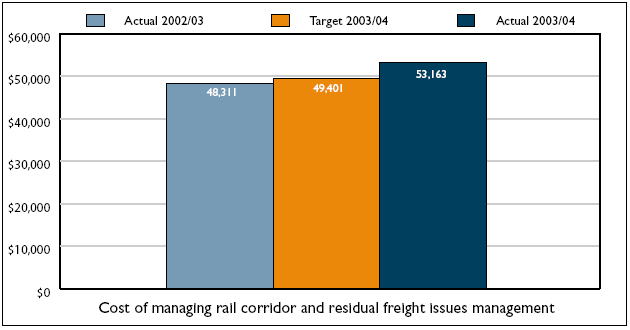
The increase
in the average cost compared to the target and the previous
year’s result was mainly due to a reallocation of the
capital user charge levy.
|



